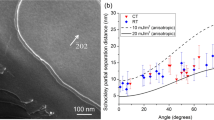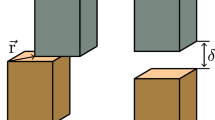Abstract
The stacking fault energy, γ, in noble metal alloys can be expressed as a sum of two terms: δufe, the contribution due to the conduction electrons; and δuc, the contribution due to thed electrons. For noble metals and alloys δuc 〉 δufe while for multivalent normal metals δufe 〉 δuc. The theory is first discussed in terms of recent calculations of the pseudopotential form factors of the noble metals (Moriarty) and some of the typical solutes (Shaw). The theory is then extended in a phenomenological fashion to include the effects of a finite relaxation time, τ, of the conduction electrons. It is shown that, for concentrated noble metal alloys with the electron-to-atom ratio,Z 〉 1.14 and multivalent normal metals, δufe and hence γ will be dependent on both temperature and deformation through their effects on τ. An increase in τ results in a decrease in the magnitude of δufe. In the case of concentrated noble metal alloys this results in an increase in γ with increasing t while for multivalent normal metals γ decreases with increasing τ.
Similar content being viewed by others
References
T. C. Tisone, R. C. Sundahl, and G. Y. Chin:Met. Trans., 1970, vol. 1, p. 1571.
T. C. Tisone and R. C. Sundahl:Solid State Commun., 1970, vol. 8, p. 843.
F. Ducastelle and F. Cyrot-Lackmann:J. Phys. Chem. Solids, 1970, vol. 31, p. 1295.
F. Cyrot-Lackmann and F. Ducastelle:J. Phys. Chem. Solids, 1971, vol. 32 p. 285.
J. A. Moriarty:Phys. Rev. B, 1970, vol. 1, p. 1363.
R. W. Shaw, Jr.:Phys. Rev., 1968, vol. 174, p. 769.
A. Blandin, J. Friedel, and G. Saada:J. Phys., 1966, vol. 27, p. C-128.
W. A. Harrison:Pseudopotentials in the Theory of Metals, p. 207, W. A. Benjamin, Inc., New York, 1966.
W. A. Harrison:Phys. Rev., 1969, vol. 181, p. 1036.
E. E. Havinga, J. H. N. Van Vucht, and K. H. J. Buschow:Phillips Res. Rep., 1969, vol. 24, p. 407.
F. Cyrot-Lackmann, F. Ducastelle, and J. Friedel:Solid State Commun., 1970, vol. 8, p. 685.
P. C. J. Gallagher and Y. C. Liu:Acta Met, 1969, vol. 17, p. 127.
A. W. Howie and P. R. Swann:Phil. Mag., 1961, vol. 6, p. 1215.
P. C. J. Gallagher and J. Washburn:Phil. Mag., 1966, vol. 14, p. 971.
A. W. Ruffand L. K. Ives:Can. J. Phys., 1967, vol. 45, p. 787.
L. Delehouzee and A. Deruythere:.Acta Met., 1967, vol. 15, p. 727.
N. H. March:Liquid Metals, p. 73, Pergamon Press, Oxford, 1968.
T. Gaskell and N. H. March:Phys. Lett., 1963, vol. 7, p. 169.
P. G. deGennes:J. Phys. Radium, 1962, vol. 23, p. 630.
W. A. Harrison:Solid State Theory, p. 300, McGraw-Hill, New York, 1970.
P. C. J. Gallagher and U. Valdre:Estratto da Atti del V Congresso Italiano di Microscopio Electronica, p. 1268, Seminario di Padova, UNESCO, 1965.
P. C. J. Gallagher:Met. Trans., 1970, vol. 1, p. 2429.
Handbuch der Physik, S. Flugge, ed., vol. 29, Elektrische Leitungsphanomene I, Springer-Verlag, Berlin, p. 156, 1956.
W. Koster and H. P. Rave:Z. Metallk., 1963, vol. 54, p. 718.
Handbuch der Physik, S. Flugge, ed., vol. 29, Elektrische Leitungsphanomene I, Springer-Verlag, Berlin, p. 210, 1956.
W. B. Pearson:Handbook of Lattice Spacings and Structures of Metals and Alloys, p. 263, Pergamon Press, London, 1958.
T. C. Tisone, J. O. Brittain, and M. Meshii:Phys. Status Solidi, 1968, vol. 27, p. 185.
L. K. Ives and A. W. Ruff:Phys. Status Solidi, 1968, vol. 27, p. 117.
J. W. Christain and P. R. Swann:Alloying Behavior and Effects in Concentrated Solid Solution, T. B. Massalski, ed., p. 105, Gordon and Breach, N. Y., 1965.
J. B. Cohen and M. Fine:J Phys. Radium, 1962, vol. 23, p. 749.
S. Matsuo and L. M. Clarebough:Acta Met., 1963, vol. 11, p. 1195.
A. W. Ruff and L. K. Ives:Nat. Bur. Stand., Washington, D. C, unpublished research, 1970.
B. Pettersson:Phi!. Mag., 1970, vol. 21, p. 831.
L. O. Salonen, J. P. Kajamoa, and A. V. A. Saariene:Z. Metallk., 1969, vol. 60, p. 802.
R. Vasudevan:J Appl. Cryst., 1970, vol. 3, p. 211.
L. Wallden:Phil. Mag., 1970, vol. 21, p. 571.
Author information
Authors and Affiliations
Rights and permissions
About this article
Cite this article
Tisone, T.C. Relaxation time effects in the stacking fault energy of noble metal alloys. Metall Trans 3, 431–439 (1972). https://doi.org/10.1007/BF02642047
Received:
Published:
Issue Date:
DOI: https://doi.org/10.1007/BF02642047




